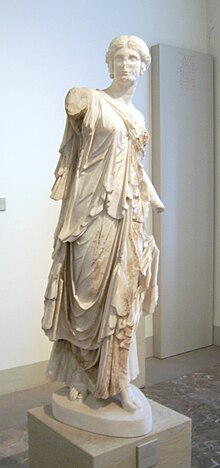Description
The statue of white translucent marble is 120 cm high (114 cm excluding the base), and the head is 14.5 m high. It depicts a young woman, with her left leg forward, giving the impression that she is moving forward. Her right hand is raised. It was made from a separate piece of stone and has not survived. Her left hand reaches downwards, lightly gripping her dress. The hand and part of the lower arm are not preserved; nor are the statue base and the feet, which have been replaced by a modern creation made of imitation marble. The clothes and face are partially damaged; her nose and many pieces of her dress are missing. The maiden wears several thin layers of fabric which hug her body closely in some parts and forming deep folds of drapery in others. The lowest layer is a sleeved chiton with very fine folds, over which she wears another, armless garment. The fine, rippling fabric is framed at the neck and shoulders by a broad border. The outermost layer is a voluminous cloak, which falls in broad, deep folds. It hangs from her right shoulder, leaving her left shoulder and left breast free and recalls in its shape the cloaks worn by archaic Kore statues of the 6th century BC. The clothing enhances the dynamism of the statue rather than concealing it. The creator of the statue played with various oppositions, as with the broad-spread posture on the one hand and the torsion of the upper body on the other. Similarly, the measured forms of archaic sculpture, with its stitched folds and closely aligned pieces of fabric on the legs, contrast with the lavish cloak flowing out behind her - an entirely different form of materiality. This use of oppositions is also seen in the head and face. Thus, the face is shown with blooming cheeks, deep-set eyes, a small, full mouth, as well as long wavy hair, held back by a band on the forehead and temples. These features are answered by rigid spiral locks of hair on the neck and in front of the ears, which are carved in an archaic style.
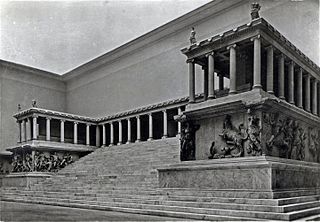
The Pergamon Altar was a monumental construction built during the reign of the Ancient Greek King Eumenes II in the first half of the 2nd century BC on one of the terraces of the acropolis of Pergamon in Asia Minor.

1840s fashion in European and European-influenced clothing is characterized by a narrow, natural shoulder line following the exaggerated puffed sleeves of the later 1820s and 1830s. The narrower shoulder was accompanied by a lower waistline for both men and women.

Fashion in the period 1550–1600 in European clothing was characterized by increased opulence. Contrasting fabrics, slashes, embroidery, applied trims, and other forms of surface ornamentation remained prominent. The wide silhouette, conical for women with breadth at the hips and broadly square for men with width at the shoulders had reached its peak in the 1530s, and by mid-century a tall, narrow line with a V-lined waist was back in fashion. Sleeves and women's skirts then began to widen again, with emphasis at the shoulder that would continue into the next century. The characteristic garment of the period was the ruff, which began as a modest ruffle attached to the neckband of a shirt or smock and grew into a separate garment of fine linen, trimmed with lace, cutwork or embroidery, and shaped into crisp, precise folds with starch and heated irons.

The Berlin Painter is the conventional name given to an Attic Greek vase-painter who is widely regarded as among the most talented vase painters of the early 5th century BC. There are no painter signatures on any of the Berlin Painter's attributed works. From the surviving vases, it is safe to assume that he was a major painter, there are over 400 vases and fragments attributed to him.

The Barberini ivory is a Byzantine ivory leaf from an imperial diptych dating from Late Antiquity, now in the Louvre in Paris. It represents the emperor as triumphant victor. It is generally dated from the first half of the 6th century and is attributed to an imperial workshop in Constantinople, while the emperor is usually identified as Justinian, or possibly Anastasius I or Zeno. It is a notable historical document because it is linked to queen Brunhilda of Austrasia. On the back there is a list of names of Frankish kings, all relatives of Brunhilda, indicating her important position. Brunhilda ordered the list to be inscribed and offered it to the church as a votive image.
The Antikensammlung Berlin is one of the most important collections of classical art in the world, now held in the Altes Museum and Pergamon Museum in Berlin, Germany. It contains thousands of ancient archaeological artefacts from the ancient Greek, Roman, Etruscan and Cypriot civilizations. Its main attraction is the Pergamon Altar and Greek and Roman architectural elements from Priene, Magnesia, Baalbek and Falerii. In addition, the collection includes a large number of ancient sculptures, vases, terracottas, bronzes, sarcophagi, engraved gems and metalwork.

The oinochoe by the Shuvalov Painter in the collection of Antikensammlung Berlin is an erotic depiction from ancient Greek vase painting.

Moschophoros is an ancient Greek statue of the Archaic period, also known in English as The Calf Bearer. It was excavated in fragments in the Perserschutt on the Acropolis of Athens in 1864. The statue, dated c. 560 BC and estimated to have originally measured 1.65 meters (5.4 ft) in height, is now in the Acropolis Museum in Athens, Greece.

The Values of Civilization sculpture group is public art by American artist Alexander Doyle. The allegorical sculpture group is located on the third floor in the rotunda of the Indiana State House, which is in Indianapolis, Indiana, United States. The heroic-sized sculptures, representing Agriculture, Art, Commerce, History, Justice, Law, Liberty, and Oratory, were carved from Carrara marble in Italy in the late 1880s.
The statuette of Aphrodite known as Aphrodite Heyl in the Antikensammlung Berlin is an especially finely worked terracotta statue from the second century BC.
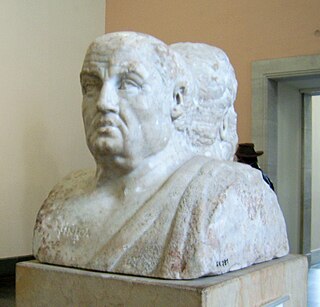
The Double Herm of Socrates and Seneca is an ancient Roman statue from the first half of the third century AD. The herm depicts the Greek philosopher Socrates on one side, and the Roman Stoic Seneca the Younger on the other. It currently belongs to the Antikensammlung Berlin, found in the Altes Museum.

The Diana of Gabii is a statue of a woman in drapery which probably represents the goddess Artemis and is traditionally attributed to the sculptor Praxiteles. It became part of the Borghese collection and is now conserved in the Louvre with the inventory number Ma 529.
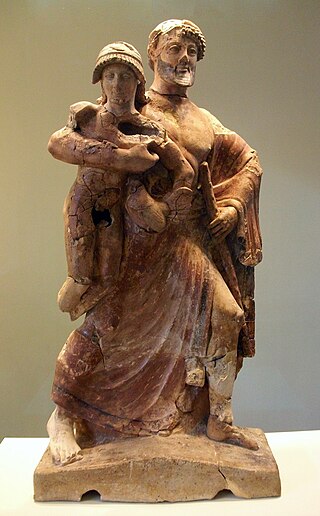
The Group of Zeus and Ganymede is a multi-figure Late Archaic Greek terracotta statue group, depicting Zeus carrying the boy Ganymede off to Mount Olympus. It was created in the first quarter of the fifth century BC and is now displayed near where it was originally found in the Archaeological Museum of Olympia.

The Antenor Kore is a Late Archaic statue of a girl (Kore) made of Parian marble, which was created around 530/20 BC.

The Kore of Lyons is a Greek statue of Pentelic marble depicting a bust of a young girl of the kore type, conserved at the musée des beaux-arts de Lyon, France. Deriving from the Athenian Acropolis, it is generally dated to the 540s BC. Considered the centrepiece of the museum's antiquities department, the statue was acquired between 1808 and 1810.

The Old Drunkard is a female seated statue from the Hellenistic period, which survives in two Roman marble copies. The original was probably also made of marble. This genre sculpture is notable for its stark realism.
The Athena with cross-strapped aegis is an ancient statue of the Greek goddess Athena, which was made around AD 150 and is now displayed in the Antikensammlung Berlin.
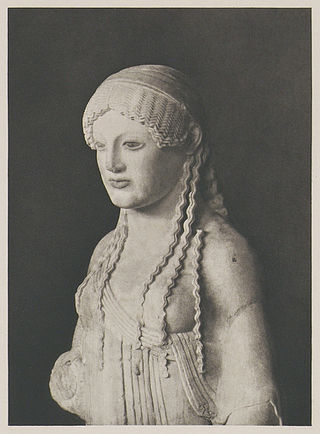
The Euthydikos Kore is a late archaic, Parian marble statue of the kore type, c 490–480 BCE, that once stood amongst the Akropolis votive sculptures. It was destroyed during the Persian invasion of 480 BCE and found in the Perserschutt. It is named after the dedication on the base of the sculpture, “Euthydikos son of Thaliarchos dedicated [me]”. It now stands in the Acropolis Museum.

The set of Six statues from the Church of St. Nicholas in Cheb is one of the finest and oldest works created by the local carving workshop in Cheb in the 1480s-90s. The statues are of similar height and may have been part of one or more Gothic altarpieces. They come from the Chapel of the Holy Cross (1388) in the now vanished village of St. Cross (Heiligenkreutz) between Cheb and Waldsassen, where they were discovered in 1856 by Bernhard Grüber. In the 1860s they were secondarily placed in the Neo-Gothic retables designed by B. Grüber in the Church of St. Nicholas in Cheb.

The Berlin Goddess, or Berlin Kore is an Archaic Greek kore made in 570 B.C. discovered in the city of Keratea, which was a part of Attica, Greece. Discovered in 1923 in a complete state, it has since then placed on display at the Antikensammlung Berlin.
